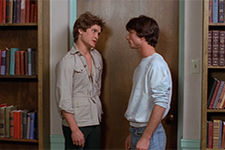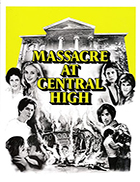Massacre at Central High
|  You don’t really notice it at first, but at some point it will dawn on you that there are virtually no adults in Massacre at Central High. I didn’t realize the absence of adults until the final 10 minutes of the film, when an “alumni prom” is being staged and there are a number of middle-aged and elderly couples dancing in the gymnasium, which jarred my realization that it was the first time I had seen someone in the film who wasn’t supposed to be a teenager. No parents. No teachers. No principal or school administrators. No cops. The film takes place in a hermetically sealed world of adolescence, which is the first clue that we should take it as something other than a run-of-the-mill Southern California teen exploitation flick. No—writer/director Rene Daalder had something different in mind, although it takes a while for that to become obvious. First, we have to get past the genuinely awful opening credits sequence, which cuts together shots from throughout the film (including some graphic flashes of violence to come and several explosions) against a syrupy ballad called “Crossroads” crooned by composer Tommy Leonetti, whose subsequent career consisted largely of scoring ABC Afterschool Specials. The disjunction between the title Massacre at Central High, the images of violence, and the almost insufferable cheesiness of the theme song will either drive you away before the film even starts or it will pique your interest and alert you to the centrality of conflict not just in the film’s drama, but in its very construction. The opening credits sequence feels like an afterschool special periodically invaded by a violent exploitation film, which is pretty much what Massacre at Central High is, but with an overlay of political messaging about the cyclical nature of fascism. It was made, after all, just a few years after Philip Zimbardo’s infamous 1971 Stanford prison experiment and the publication of Stanley Milgram’s 1974 book Obedience to Authority: An Experimental View, which was based on his 1960s experiments in blind obedience. The story draws heavily on high school drama cliches, starting with the arrival of “the new kid,” a seemingly innocuous high school senior named David (Derrel Maury), who quickly realizes that his new school is run by a dictatorial quartet of well-heeled bullies led by Bruce (Ray Underwood, who feels very Pretty in Pink-era James Spader-ish in his laconic sadism). One of the bullies is Mark (Andrew Stevens), who David knew at another school and whom he helped at some point, which leads Mark to want to help David by ensuring that he is part of the “in” group, rather than the “out” group of social misfits the bullies constantly threaten and harass. David doesn’t want any part of it, and he even stands up to Bruce and his gang, which puts him in their crosshairs despite Mark’s constant pleading and the help his longtime girlfriend, Theresa (Kimberly Beck), with whom David falls in love. Things turn truly violent when David is injued in an incident that may or may not have been accidental, at which point he turns from stern protector of the abused to murderous serial killer who picks off the bullies one by one in variously clever (and highly unlikely) ways. And, if that were all the film had to offer, it would indeed be a run-of-the-mill ’70s teensploitation revenge thriller. But, that is not at all what Daalder had in mind, as the second half of the film shifts to a twist on the old adage about how power abhors a vacuum. As David takes out the bullies, there is no one left to boss around the students and “keep them in line,” so their previous victims, which include an awkward hippie (Robert Carradine), a hearing-impaired library assistant, and the proverbial “fat kid,” decide to step up and take their place. Thus, the victims of fascism become fascists in their own right, which in some ways is even worse that Bruce and his gang because they feel that their cruelty is justified by both their previous victimhood and their assurance in their own intellectual and social righteousness (as The Who told us, “Come meet the new boss, same as the old boss”). It is only appropriate that Robert Carradine plays one of the victims-turned-bullies, since Massacre at Central High is essentially a bloody and politically attuned precursor to Revenge of the Nerds (1984). Daalder, who was making his American debut, was a Dutch filmmaker and music producer who had been part of an anti-auteruist film collective in the 1960s called the “1,2,3 Group,” which also included documentarian Frans Bromet, computer programmer and artist Samuel Meyering, journalist-turned-architect Rem Koolhaas, and cinematographer Jan De Bont, who would go on to become a major figure in 1980s and ’90s American action cinema with films such as Die Hard (1988) and Speed (1994). Outside of his work with the 1,2,3 Group, Daalder had directed a pair of documentary shorts and one feature-length film in Holland, the noir-ish The White Slave (De blanke slavin, 1969), which Koolhaas co-wrote. Massacre at Central High came about largely through Daalder’s friendship with soft-core maverick Russ Meyer, with whom he was originally going to collaborate on a way-ahead-of-its-time film called Hollywood Tower that envisioned a near-future in which all the Hollywood studios had been sold to oil tycoons and movies were all made by computers with digital avatars of deceased stars. Daalder’s career as a filmmaker after Massacre at Central High was uneven and sporadic. More than a decade passed before he directed another feature, Population: 1 (1986), an experimental, post-apocalyptic science fiction punk musical. It was then another 11 years before he directed the sci-fi thriller Habitat (1997) and the horror film Hysteria (1997). His final feature, Here Is Always Somewhere Else, a film about the experimental Dutch artist Bas Jan Ader, returned him to his roots in documentary. And, although his filmmaking was infrequent, he was never inactive, as he was constantly innovating and working in various areas of design, digital effects, experimental art, virtual reality, and computer programming. It is curious, then, that given what an eclectic and wide-ranging artist and innovator Daalder was, that Massacre at Central High is so aesthetically mundane. Some of it probably had to do with budget limitations, and he was also likely hampered by the dictates of commercially driven exploitation film, which would have discouraged his getting too “out there.” Watching Massacre, you would never know it was made by the former member of a film collective who would go on to be a major technological innovator, although it is clearly the product of someone with an interest in human nature and a desire to push boundaries. What it lacks in visual ingenuity and polish, it more than makes up for with its thematic daring and fierce perspective on the cycle of human violence, and it is not surprising that it was taken up and celebrated by mainstream film critics like Vincent Canby of The New York Times and Roger Ebert, although it wasn’t until the film was in heavy rotation on the midnight movie circuit four years after its initial theatrical release that they noticed its existence. It has become something of a forgotten film since then (outside of cult film circles, anyway), and even with its various flaws and shortcomings, it deserves more attention as a uniquely daring attempt to invigorate staid exploitation fare with an incisive social intelligence.
Copyright © 2022 James Kendrick Thoughts? E-mail James Kendrick All images copyright © Synapse Films | |||||||||||||||||||||||||||||
Overall Rating: 

 (3)
(3)


